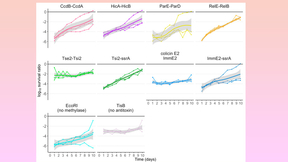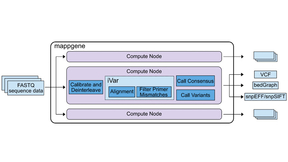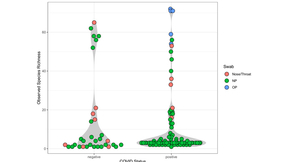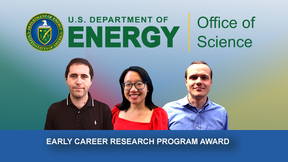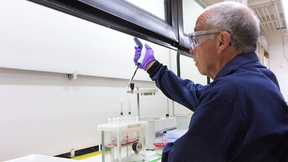Back
Biosciences and Biotechnology
“Kill switch” design strategies for genetically modified organisms
Synthetic biology promises to sustainably produce commodity chemicals, treat human disease, steward the environment, and sustain agriculture. Each of these tasks exploit genetically modified organisms (GMO), but the unintended release (referred to as “escape”) of GMOs or their recombinant (non-native) DNA could disturb native ecosystems in unpredictable ways…
Four Lab postdocs selected to attend the 72nd annual Lindau Nobel Laureate meeting
Four Lawrence Livermore National Laboratory (LLNL) postdoctoral appointees have been selected to attend the 72nd annual Lindau Nobel Laureate meeting in Germany this summer thanks to the University of California President’s 2023 Lindau Nobel Laureate Meetings Fellows Program. The four selected to attend are Wonjin Choi, Sean Leonard, Sijia Huang and Sarah Sandholtz. The…
LLNL scientists develop model for more efficient simulations of protein interactions linked to cancer
Lawrence Livermore National Laboratory scientists have developed a theoretical model for more efficient molecular-level simulations of cell membranes and their lipid-protein interactions, part of a multi-institutional effort to better understand the behavior of cancer-causing membrane proteins. Developed under an ongoing collaboration by the Department of Energy (DOE) and…
Early COVID-19 mutations associated with later variants
The emergence, spread, and evolution of severe acute respiratory syndrome coronavirus-2 (SARS-CoV-2) has been chronicled by the scientific community with greater speed and depth than any other human pathogen due to the advent of widespread genomic sequencing. To facilitate this, numerous websites and dashboards have been created to enable the visualization and…
Evaluating co-circulating pathogens in COVID-19 samples
During the first months of the COVID-19 pandemic, beyond singular infection with SARS-CoV-2, reports of co-infection (or secondary infection) with other respiratory pathogens emerged. Co-infections with SARS-CoV-2 have the potential to affect disease severity and morbidity, however, the potential influence of the nasal microbiome on COVID-19 illness is not well understood…
LLNL biomedical licensee collaborating with two drug companies to advance treatments for autoimmune diseases
People afflicted with autoimmune diseases may someday receive help through treatments now under development by a Lawrence Livermore National Laboratory (LLNL) licensee and its’ collaborations with two major pharmaceutical companies. In late 2017, LLNL licensed a biomedical technology called nanolipoprotein particles (NLPs), which can deliver vaccines and drugs inside the…
Charging up with carbon nanotubes
Lawrence Livermore National Laboratory (LLNL) scientists have created vertically aligned single-walled carbon nanotubes on metal foils that could be a boon for energy storage and the electronics industry. Vertically aligned carbon nanotubes (VACNTs) have exceptional mechanical, electrical and transport properties in addition to an aligned architecture, which is key for…
LLNL Forensic Science Center team develops new technique to analyze fentanyl in blood and urine
A team of Lawrence Livermore National Laboratory (LLNL) scientists has developed a new technique to analyze fentanyl in human blood and urine samples that could aid work in the fields of medicine and chemical forensics. Led by Carlos Valdez, an LLNL synthetic chemist and lead author, the team discussed its new fentanyl analysis approach in a paper recently published in the…
New method unearths improved understanding of soil microbial interactions
Linking the identity of wild microbes with their physiological traits and environmental functions is a key aim for environmental microbiologists. Of the techniques that strive for this goal, Stable Isotope Probing — SIP — is considered the most effective for studying active microorganisms in natural settings. Lawrence Livermore National Laboratory (LLNL) scientists have…
Lab researchers study Rift Valley fever virus
Immune responses could be supported by drugs to help people recover from brain infections caused by Rift Valley fever virus Research by Lawrence Livermore National Laboratory (LLNL) scientists suggests that immune responses could be bolstered by drugs to help people recover from brain infections caused by an emerging pathogen. The emerging pathogen studied by the team,…
Lab microbial array used in space station study
A five-year microbial study of the International Space Station (ISS) and its astronauts by Lawrence Livermore National Laboratory (LLNL) and NASA researchers has found that the ISS habitat is safe for its residents. The research effort represents the first comprehensive characterization of the space station’s environmental profile (or microbiome) and is the first to…
From batteries to water purifiers, carbon nanotubes are where it’s at
Lawrence Livermore National Laboratory (LLNL) scientists are scaling up the production of vertically aligned single-walled carbon nanotubes (SWCNT) that could revolutionize diverse commercial products ranging from rechargeable batteries, automotive parts and sporting goods to boat hulls and water filters. The research appears in the journal Carbon. Most CNT production…
PLS postdocs to compete in the 2022 Bay Area Research Slam
On September 20, LLNL hosted its annual Postdoc Research Slam. This Lab-wide competition encourages postdocs to showcase their research in a three-minute presentation that answers the question, “Why is my research important?” The event gives postdocs the opportunity to improve their communication and speaking skills and challenges them to articulate their research in an…
Joining the Fight to Cure Neurodegenerative Disease
The Laboratory’s cutting-edge capabilities and expertise offer new tools to study ALS disease mechanisms and fuel hope for a cure.
Performing a cross-scaffold search for genomic islands
Gareth Trubl and researchers from Sandia National Laboratories have created a new computer tool called Tiger2 that scans DNA and looks for genomic islands—sections that look different than the surrounding DNA. Genomic islands are important for understanding life, infection, evolution, and more. These sections typically house antibiotic resistant and toxin producing genes…
LLNL cancer research goes exascale
A Lawrence Livermore National Laboratory (LLNL) team will be among the first researchers to perform work on the world’s first exascale supercomputer — Oak Ridge National Laboratory’s Frontier — when they use the system to model cancer-causing protein mutations. Led by Harsh Bhatia, a computer scientist in the Center for Applied Scientific Computing (CASC) at LLNL, the team…
DOE honors three early-career Lab scientists
Three scientists from Lawrence Livermore National Laboratory (LLNL) are recipients of the Department of Energy’s (DOE) Office of Science Early Career Research Program award. Mimi Yung, John Despotopulos and Timofey Frolov are among 83 awardees receiving the recognition. Under the program, typical awards for DOE national laboratory staff are $500,000 per year for five years…
LLNL garners 'A' grade in OPCW environmental test
Even after taking highly stressful exams in college, grades can still be important. Just ask researchers at Lawrence Livermore National Laboratory’s (LLNL) Forensic Science Center (FSC). Every fall, chemists and other researchers from the FSC spend two weeks of long days undertaking the Organisation for the Prohibition of Chemical Weapons (OPCW) environmental proficiency…
LLNL study on tumor/immune cell interaction could impact cancer immunotherapies
Lawrence Livermore National Laboratory (LLNL) scientists exploring the interaction between cancer cells and the extracellular matrix (ECM) — the “scaffolding” of organs — found that proteins in the ECM can dramatically impact the immune system’s ability to kill tumors. Researchers said the findings, published online in the journal Biomaterials, could represent a novel…
Dead or alive: microorganisms in soil shape the global carbon cycle
Whether dead or alive, soil microorganisms play a major role in the biogeochemical cycling of carbon in the terrestrial biosphere. But what is the specific role of death for the bacteria, fungi and microfauna that make up the soil microbiome? That is the topic of a new review by Lawrence Livermore National Laboratory (LLNL) scientists and collaborators. The article,…


